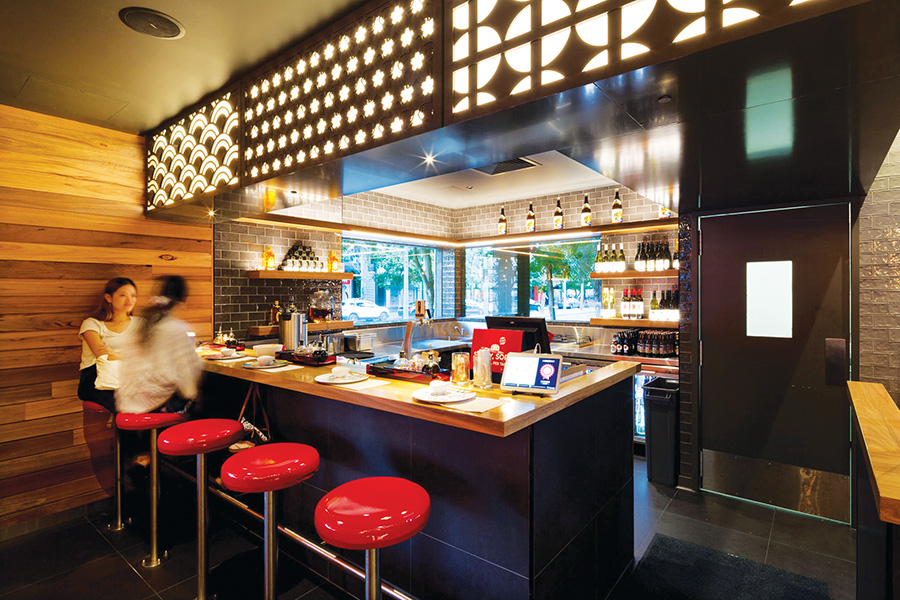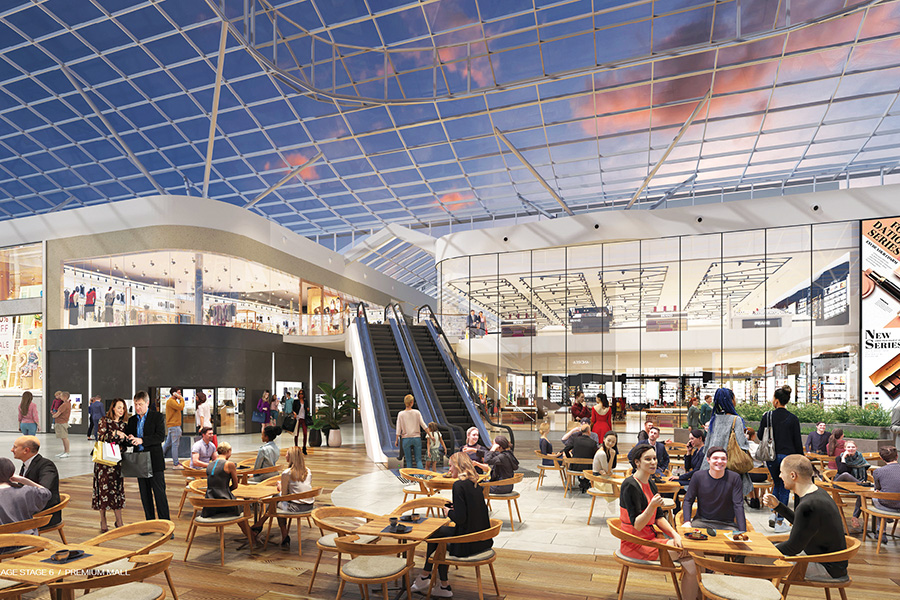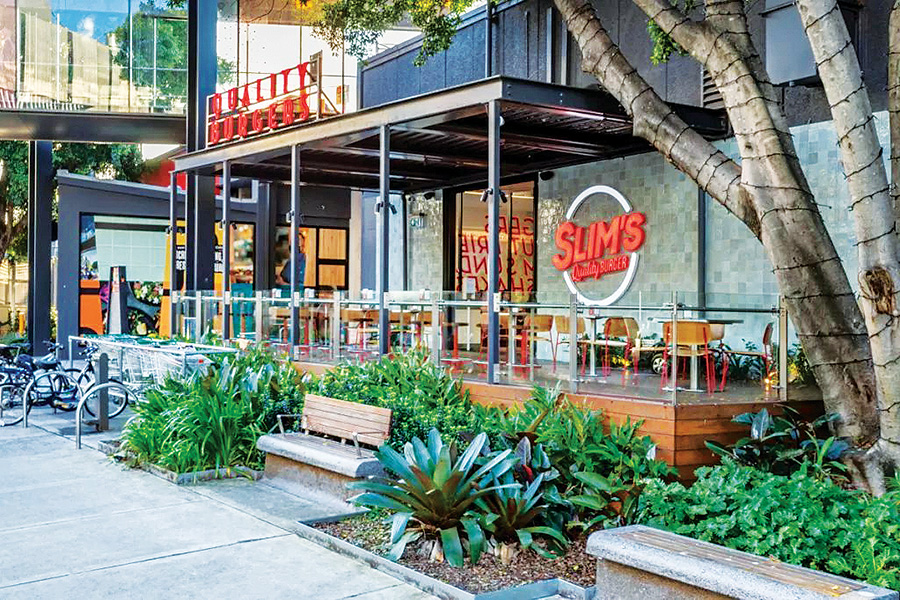In this article, Allan Forsdick of Future Food unravels the threads that connect hospitality and centre productivity in the unique environment of Little Guns.
The experience economy remains at the forefront of consumer decision-making, and even while the national economy continues to provide testing conditions, we are seeing ongoing success in dining precincts, food halls, cafes and casual dining collectives. Food and hospitality continue to be significant drivers in the growth of moving annual turnover (MAT) and productivity in the high street, in mixed-use developments and in shopping centres.
As reported in the Monthly Household Spending Indicator, hotels, cafes and restaurants continue to be one of the largest growth sectors, with only transport and health outperforming it. It is a resilient category far outpacing growth in clothing, furnishings, as well as food (grocery), alcohol and tobacco. It seems that while we may forego purchases of ‘things,’ we still love to treat ourselves, and food and hospitality appear to be the means by which we like to do it!
It’s little wonder that Little Guns take full advantage of this opportunity. In comparison to Big Guns, they perform very similarly, or in many cases better. Big Guns have a larger gross lettable area (GLA) and, therefore, can frequently exhibit a greater diversity of offers. However, over long-term trends, Little Guns usually perform better in terms of footfall and population per square metre of GLA, they frequently have a higher productivity measure (MAT/m2), and since Little Guns do perform so well on a normalised basis, there is no reason that Little Guns should have an F&B offer that is inferior to their bigger relatives.
Geographically located at the centre of their communities, Little Guns are localised and connected to their catchments in ways that the larger centres cannot match. Yet, all too frequently, they offer a predictable F&B mix full of forgettable experiences and ‘low-hanging fruit’ leasing solutions.

Juliana’s Cucina & Bar, Moonee Ponds, Melbourne
Intelligent hospitality strategy
Well-planned, strategically positioned food and hospitality can be a powerful force driving the performance of amazing Little Gun shopping centres in the heart of our communities, making them perfectly located to create social hubs, far more than just places to shop.
Curating the hospitality and social experience to the unique attributes of the location and its community is key; the successful centres in the category have elevated the significance of culinary experiences and hospitality as integral components of their offer.
They contribute to the overall liveability of the communities they are at the centre of; frequently acting as ‘town centres’ and social hubs for our evolving lifestyles. Food and hospitality have proven to be powerful attractions for drawing in customers and increasing the amount of time they spend at these centres. This also highlights the advantages that food and hospitality offerings can provide to smaller centres that feature a wide range of dining options, including both casual and smart casual dining venues, along with a diverse array of entertainment and leisure possibilities.
Once dependent on food courts and fresh food clusters, successful Little Gun centres understand a new approach has emerged that centres on dining and hospitality with optimised operational performance. Cafes and casual dining are captivating categories that customers seek out at an elementary level, but there is a growing trend towards unique offers such as street food collectives, rooftop or wine and cocktail bars, brew-pubs, or specialty bar concepts and premium casual dining. Little Guns are elevating their status to align with our aspirations of what a true neighbourhood centre can and should be.

Harajuku Gyoza, South Bank, Brisbane
Our lifestyles have shifted so rapidly and effortlessly, many people remain very concentrated in our residential neighbourhoods for four to five days out of seven. But Little Guns are a resilient asset class, as demonstrated during the challenges of 2021, when fewer than one-third of Little Guns centres registered negative MAT, while the rest recorded positive increases. And in 2022, the majority bounced back quickly, no doubt as a result of their approachable retail mixes, convenient daily visitation drivers, anchored by high-performing mini-majors and supermarkets.
Burnside Village, currently a Mini Gun (with a GLA less than 20,000m2) is set to burst into the Little Gun bracket. Located in Adelaide’s affluent inner-eastern suburbs, it is currently undergoing a significant redevelopment (opening March 2025), driven by growth in international premium retailers, youth fashion, entertainment and a best-in-class F&B offer.

Burnside Village, Adelaide
As self-appointed community cores, prominent Little Guns understand that F&B productivity (MAT/m2) is frequently above centre averages, or put another way, F&B over indexes. This frequently points to a business case that prescribes a greater percentage of leasable area to on-trend, enthralling food and hospitality. (Many centres in our international projects exceed 15% F&B GLA attribution).
The driving force behind this is the expansion of food and beverage leasable area, which leads to enhanced performance and the square metres of merchandise available for sale (MAT/m2) for non-food retail anchors and smaller specialty stores. This, in turn, can capitalise on increased foot traffic and provide customers with more reasons to spend, driven by the convenience that comes with their visit. In the case of smaller shopping centres, especially those with larger GLA areas facing external features like parking lots, main roads and high streets, there is a clear desire to activate the perimeters. This not only ensures visual appeal throughout the day but also creates a welcoming and attractive statement for the centre.
It is not just property owners and managers that understand this, many operators are diversifying their strategies away from sole reliance on bigger centres, with regional exposure. They understand that many Little Gun centres are the big game in town! They want to ensure that people are exposed to their brands in the centres where people are living, working and playing.
High-performing Little Guns stand out on the merits of their diverse dining options, a meticulously curated mix of food and hospitality operators. This deliberate selection process ensures that each operator contributes to the overall character aligned with the centre’s wider strategy and augments the experience beyond shopping; a destination in and of itself. Little Guns possess the advantage of catering to their specific demographic by placing a substantial emphasis on culinary offerings. This is an area where Big Guns might not capitalise, due to their need to serve a broader catchment area, which can limit their ability to tailor their offerings to a specific audience.
Little Gun shopping centres can and are shaping suburban lifestyle trends. But their success isn’t a stroke of luck. It is a well-thought-out strategy that places hospitality at the core of the centre’s identity. The symbiotic relationship between well-planned, strategically-positioned hospitality and centre success is evident in the increased foot traffic, elevated customer experiences and the creation of vibrant, community-centric destinations. As other shopping centres look to emulate success, the story of the ‘Little Guns’ serves as a blueprint, illustrating that the future of retail lies not just in what you sell but in how you make people feel.
This article is featured in the latest issue of SCN magazine. View the full digital edition here





















